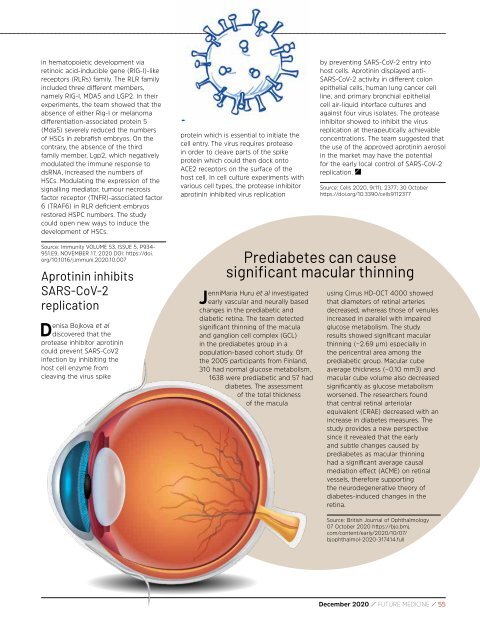Create successful ePaper yourself
Turn your PDF publications into a flip-book with our unique Google optimized e-Paper software.
in hematopoietic development via<br />
retinoic acid-inducible gene (RIG-I)-like<br />
receptors (RLRs) family. The RLR family<br />
included three different members,<br />
namely RIG-I, MDA5 and LGP2. In their<br />
experiments, the team showed that the<br />
absence of either Rig-I or melanoma<br />
differentiation-associated protein 5<br />
(Mda5) severely reduced the numbers<br />
of HSCs in zebrafish embryos. On the<br />
contrary, the absence of the third<br />
family member, Lgp2, which negatively<br />
modulated the immune response to<br />
dsRNA, increased the numbers of<br />
HSCs. Modulating the expression of the<br />
signalling mediator, tumour necrosis<br />
factor receptor (TNFR)-associated factor<br />
6 (TRAF6) in RLR deficient embryos<br />
restored HSPC numbers. The study<br />
could open new ways to induce the<br />
development of HSCs.<br />
protein which is essential to initiate the<br />
cell entry. The virus requires protease<br />
in order to cleave parts of the spike<br />
protein which could then dock onto<br />
ACE2 receptors on the surface of the<br />
host cell. In cell culture experiments with<br />
various cell types, the protease inhibitor<br />
aprotinin inhibited virus replication<br />
by preventing SARS-CoV-2 entry into<br />
host cells. Aprotinin displayed anti-<br />
SARS-CoV-2 activity in different colon<br />
epithelial cells, human lung cancer cell<br />
line, and primary bronchial epithelial<br />
cell air-liquid interface cultures and<br />
against four virus isolates. The protease<br />
inhibitor showed to inhibit the virus<br />
replication at therapeutically achievable<br />
concentrations. The team suggested that<br />
the use of the approved aprotinin aerosol<br />
in the market may have the potential<br />
for the early local control of SARS-CoV-2<br />
replication.<br />
Source: Cells <strong>2020</strong>, 9(11), 2377; 30 October<br />
https://doi.org/10.3390/cells9112377<br />
Source: Immunity VOLUME 53, ISSUE 5, P934-<br />
951.E9, NOVEMBER 17, <strong>2020</strong> DOI: https://doi.<br />
org/10.1016/j.immuni.<strong>2020</strong>.10.007<br />
Aprotinin inhibits<br />
SARS-CoV-2<br />
replication<br />
Denisa Bojkova et al<br />
discovered that the<br />
protease inhibitor aprotinin<br />
could prevent SARS-CoV2<br />
infection by inhibiting the<br />
host cell enzyme from<br />
cleaving the virus spike<br />
Prediabetes can cause<br />
significant macular thinning<br />
JenniMaria Huru et al investigated<br />
early vascular and neurally based<br />
changes in the prediabetic and<br />
diabetic retina. The team detected<br />
significant thinning of the macula<br />
and ganglion cell complex (GCL)<br />
in the prediabetes group in a<br />
population-based cohort study. Of<br />
the 2005 participants from Finland,<br />
310 had normal glucose metabolism,<br />
1638 were prediabetic and 57 had<br />
diabetes. The assessment<br />
of the total thickness<br />
of the macula<br />
using Cirrus HD-OCT 4000 showed<br />
that diameters of retinal arteries<br />
decreased, whereas those of venules<br />
increased in parallel with impaired<br />
glucose metabolism. The study<br />
results showed significant macular<br />
thinning (−2.69 μm) especially in<br />
the pericentral area among the<br />
prediabetic group. Macular cube<br />
average thickness (−0.10 mm3) and<br />
macular cube volume also decreased<br />
significantly as glucose metabolism<br />
worsened. The researchers found<br />
that central retinal arteriolar<br />
equivalent (CRAE) decreased with an<br />
increase in diabetes measures. The<br />
study provides a new perspective<br />
since it revealed that the early<br />
and subtle changes caused by<br />
prediabetes as macular thinning<br />
had a significant average causal<br />
mediation effect (ACME) on retinal<br />
vessels, therefore supporting<br />
the neurodegenerative theory of<br />
diabetes-induced changes in the<br />
retina.<br />
Source: British Journal of Ophthalmology<br />
07 October <strong>2020</strong> https://bjo.bmj.<br />
com/content/early/<strong>2020</strong>/10/07/<br />
bjophthalmol-<strong>2020</strong>-317414.full<br />
<strong>December</strong> <strong>2020</strong> / FUTURE MEDICINE / 55

















